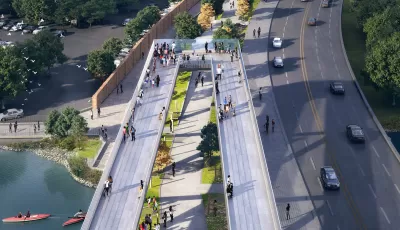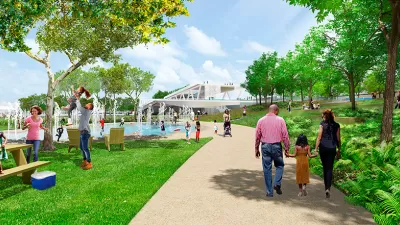Project leaders working on the 11th Street Bridge Park hope to prevent displacement of residents and bring economic and social benefits to the surrounding community.

Planners for a new park in Washington, D.C. want to avoid the pitfalls encountered during the development of New York City’s High Line, writes Cari Shane in Fast Company.
The 11th Street Bridge Park, first proposed a decade ago, will transform a defunct bridge into a pedestrian-only park that will connect the two sides of the Anacostia River. Scott Kratz, head of the 11th Street Bridge Park project, says he and his team want to avoid the “eco-gentrification” that drove up housing costs and displaced residents near the High Line.
“One of the most important ideas behind the project was to make sure that the Black community east of the river benefited from the added value that the park would bring,” such as programs that help renters become homeowners and small business owners buy their properties. According to the article, “In total, $86 million has been invested on the equitable development side of the bridge park project. That includes $14 million in charitable donations raised by the bridge park and an investment of $72 million from the Local Initiatives Support Corporation, a federally certified nonprofit that serves low-income communities throughout the U.S.”
The article details the plan for the park, designed by Dutch firm OMA and U.S.-based landscape architecture studio Olin. Construction is expected to begin in early 2024.
FULL STORY: How D.C.’s version of the High Line aims to avoid New York’s mistakes

Study: Maui’s Plan to Convert Vacation Rentals to Long-Term Housing Could Cause Nearly $1 Billion Economic Loss
The plan would reduce visitor accommodation by 25,% resulting in 1,900 jobs lost.

North Texas Transit Leaders Tout Benefits of TOD for Growing Region
At a summit focused on transit-oriented development, policymakers discussed how North Texas’ expanded light rail system can serve as a tool for economic growth.

Why Should We Subsidize Public Transportation?
Many public transit agencies face financial stress due to rising costs, declining fare revenue, and declining subsidies. Transit advocates must provide a strong business case for increasing public transit funding.

How to Make US Trains Faster
Changes to boarding platforms and a switch to electric trains could improve U.S. passenger rail service without the added cost of high-speed rail.

Columbia’s Revitalized ‘Loop’ Is a Hub for Local Entrepreneurs
A focus on small businesses is helping a commercial corridor in Columbia, Missouri thrive.

Invasive Insect Threatens Minnesota’s Ash Forests
The Emerald Ash Borer is a rapidly spreading invasive pest threatening Minnesota’s ash trees, and homeowners are encouraged to plant diverse replacement species, avoid moving ash firewood, and monitor for signs of infestation.
Urban Design for Planners 1: Software Tools
This six-course series explores essential urban design concepts using open source software and equips planners with the tools they need to participate fully in the urban design process.
Planning for Universal Design
Learn the tools for implementing Universal Design in planning regulations.
City of Santa Clarita
Ascent Environmental
Institute for Housing and Urban Development Studies (IHS)
City of Grandview
Harvard GSD Executive Education
Toledo-Lucas County Plan Commissions
Salt Lake City
NYU Wagner Graduate School of Public Service




























